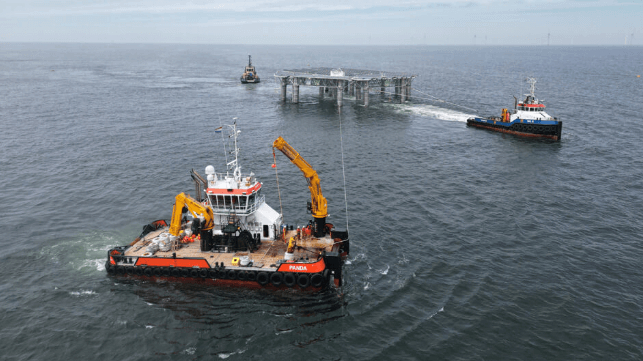Floating Solar Pilot Launched in Dutch North Sea to Test Technology

The Merganser project has been successfully installed in the Dutch North Sea as the first step toward testing and demonstrating the technology. Developed by the Dutch-Norwegian company SolarDuck with the support of RWE, they plan to monitor the performance while exploring the possibilities of integrating solar power into offshore wind farms.
German energy giant RWE announced two years ago that it would be exploring integrating floating solar technology into offshore wind farms to create more efficient use of ocean space for energy generation. The company said it was attracted to the concept both as a means to address increasing land scarcity for the generation of renewable energy and as an alternative in locations where wind is less suited for power generation.
“Standalone or also in combination with offshore wind farms, offshore floating solar could open up further offshore renewable energy opportunities – especially for countries with lower average wind speeds but lots of sunlight,” said Sven Utermohlen, CEO of RWE Offshore Wind.
RWE in 2022 won a Dutch auction for the Hollandse Kust (west) Wind Farm Zone. As part of the project, the company proposed integrating SolarDuck’s solution to meet the requirements of the solicitation. SolarDuck was commissioned to develop the demonstration system while other options in the auction include incorporating batteries into offshore wind farms and using space in the sites for offshore hydrogen production.
Merganser has a capacity of 0.5 megawatt peak. The project which consists of six interconnected platforms was towed into its location approximately 7.5 miles off the coast of Scheveningen. The floating platforms were successfully connected to the mooring system at a water depth of 20 meters (65 feet).
One of the key challenges is to develop a platform that can withstand rough offshore conditions. The North Sea is well known for its strong wind and high sea conditions. SolarDuck´s triangular-shaped platform is designed to float several meters above the water. According to the company, the design will be able to keep critical components dry, clean, and stable, as well as secure the structural integrity of the semi-submersible floating structure. The design received recently the world’s first certification for OFPV by Bureau Veritas.

that matters most
Get the latest maritime news delivered to your inbox daily.
Over the coming two years, Merganser will be monitored remotely with more than 180 sensors fitted to report structural loads, connector and mooring loads, and electrical performance. The companies said this test will provide critical information for the development and commercialization of the technology.
The Hollandse Kust (west) Wind Farm Zone calls for two projects, one to be developed by RWE, and the other was awarded to a consortium of Shell and Eneco. The zone is located approximately 30 miles off the west coast of the Netherlands. It will accommodate around 1,400 MW, split between the two projects, and has a target date to start operating by the end of 2026.
